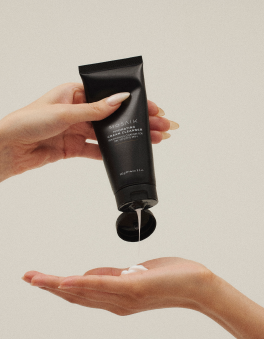Hyperpigmentation

Hyperpigmentation is the darkening of skin pigment, in comparison to the natural occurring pigment colour of the skin. This can be a result of photodamage, hormonal changes, age, as well as external and/or internal pollutants and/or stressors over the period of a lifetime.
Hormonal Skin Concerns

Hormonal skin concerns are often due to an imbalance in the bodies naturally occurring hormones such as progesterone, testosterone and estrogen. These hormones communicate with sebaceous glands (sebum production) and can result in adverse effects such as acne or hyperpigmentation.
Dry Skin

Dry skin is characterised by less production of natural sebum and as a result, the skin tends to be dry, rough, and sometimes cracked or flaky-looking. Dry skin is more susceptible to irritation and infection as a lack of moisture means that the skin’s protective barrier is compromised.
Combination Skin (All)

Just like the name suggests, this skintype is a combination of different skintypes and can range from very dry to very oily. Different regions of the face can have different skintypes, i.e. the T-zone can be oily with dry skin in alternate areas.
Dull Skin

Dull skin is the consequence of an increased ratio of dead skin cells which appear dry and rough in texture. As a consequence, skin lacks luminosity and can have a lacklustre appearance.
Balanced Skin

Refers to skin that has well-balanced sebum and moisture production - it is not too oily and not too dry. Balanced skin has refined pores and no visible blemishes, flaky areas or oily spots.
Oiliness

Oily skin occurs where sebaceous glands produce excess sebum, consequently the individual is prone to breakouts, blackheads and acne. Pores are generally visibly larger and the skin surface shiny.
Ageing & Hyperpigmentation

Ageing & Hyperpigmentation refer to the chronological effects that influence the skin’s condition, tone, and overall health. The loss of elasticity, tone, brightness, and strength can all be the result of chronological ageing. Hyperpigmentation is the darkening of skin pigment, in comparison to the natural occurring pigment colour of the skin. This can be a result of photodamage, hormonal changes, age, as well as external and/or internal pollutants and/or stressors over the period of a lifetime.
Never Burns

Exposure to ultraviolet radiation, UVA or UVB rays does not easily cause damage to the skin. Never burning suggests that there is no appearance of redness on the skin, and the likelihood of damage to the skin cells is reduced, this damage could otherwise progress to DNA damage which is irreversible and can result in melanoma.
Rarely Burns

Exposure to ultraviolet radiation, UVA or UVB rays rarely causes damage to the skin. Rarely burning suggests that there is an infrequent appearance of redness on the skin, and the likelihood of damage to the skin cells is reduced, this damage could otherwise progress to DNA damage which is irreversible and can result in melanoma.
Usually Burns

Exposure to ultraviolet radiation, UVA or UVB rays usually causes damage to the skin. When the skin burns, not only does the surface appear red and often increase in temperature, it can also cause damage to the skin cells. This surface damage can progress to DNA damage which is irreversible and can result in skin cancers.
Burns Very Easily and Quickly

Exposure to ultraviolet radiation, UVA or UVB rays always and quickly causes damage to the skin. When the skin burns, not only does the surface appear red and often increase in temperature, it also causes damage to the skin cells. This surface damage can progress to DNA damage which is irreversible and can result in melanoma.
Other

A skin concern that does not fit into any other defined category of concern, but is of a specific and notable concern to the individual.
Acne

Acne is caused by any blockage of a pore on the skin's surface, there are multiple different types of acne. These obstructions can be caused by individual or combinations of matter including excessive sebum, dead skin cells, bacteria and/or dirt, and can result in inflammation and/or irritation.
Ageing: Fine Lines and Wrinkles

The structure of the skin becomes increasingly thin over time due to intrinsic and extrinsic ageing effects, resulting in a depletion of collagen, elastin, and hyaluronic acid. These implications result in the skin becoming progressively dry as well as an increase in the presence of fine lines and wrinkles.
Sensitivity

Sensitive skintypes have skin that becomes flushed and red easily, possesses dry patches, is easily itchy/irritated, and displays hypersensitivity to changes in weather (temperature). Sensitive skintypes often have difficulty switching products as they can react quickly to ingredients that are too harsh or irritating for their skin.
Loss of Firmness

The structure of skin becomes increasingly thin over time due to intrinsic and extrinsic ageing effects. This is a consequence of a depletion in collagen, elastin, and hyaluronic acid. The skin can consequently sag or appear crepey.
Dark Circles

Skin under the eyes appears to be darker to that of surrounding areas. This can be caused by a multitude of extrinsic and/or intrinsic factors including lack of sleep, exhaustion, dehydration, or hyperpigmentation.
Large Pores

Large pores are predetermined (genetic); however, how they appear may be influenced by intrinsic or extrinsic factors. Examples include, excessive levels of sebum being produced, ageing, overall condition of the skin, stress, inflammation and acne, and even lifestyle habits such as smoking.
Red and Irritated Skin

Skin that changes in physical appearance and texture due to external or internal factors. For example, sunburn or blocked pores can result in inflammation, uneven surface, itchiness and irritation, and in severe cases, pain.






























